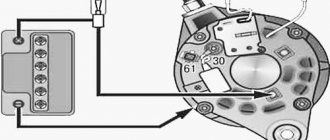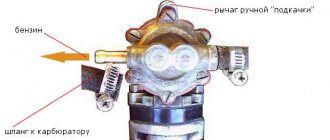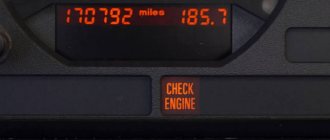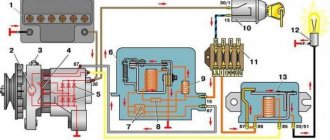When the engine starts, there is a normal charge; as the engine heats up, the charge level becomes less. I changed the “chocolate”, stretched the ground wires - nothing changed. I removed the generator and sent it for diagnostics - they said that everything was working, normal. I don’t even know what to do anymore. They say that this often happens in injection classics.
- Why does the VAZ 2107 battery drain quickly? – 6 answers
- It's hard to start a car - 3 answers
- The battery on the 2107 was not connected correctly – 6 answers
- Tachometer needle jumps at 2107 - 6 answers
- Why might the new generator fail? – 6 answers
I have a similar situation with the 2107 classic injector. If the issue is resolved, please share your experience. I replaced both the LV and the diode assembly on the standard generator, and even replaced it with two new generators. I replaced the negative wire and moved its other end from the cylinder block to the receiver bolt. I called and cleaned all available contacts and terminals. Now I’m working on a version of detecting a current leak or connecting an unauthorized consumer. Which appears only when the load is turned on, in the form of headlights, heaters, emergency lights, glass heater, etc. A pointer tester is only needed for measurements. Turn it on in DC current measurement mode at a high limit, probably 10 A, between the battery terminal and the tip of the negative (or positive) wire. Turn on the ignition, look at the ammeter readings, at least before turning on the radiator fan. Record the constant value or change in current, within what limits and for how long. Gradually add a load (connect low beam, then high beam, then others) and monitor the change in current in a similar way. An anomalous value should appear, something higher than 7-8 A. After identifying such a current value, take turns on the mounting block, remove the fuses and monitor the ammeter needle. There will be a fuse, after disconnecting which the current will decrease to less than 7-8 A, jump or stop changing. The circuit that this fuse protects should be carefully examined for its connections, routing locations, etc. It would be good, for clarity, to connect a voltmeter to the battery terminals. I myself, urgently, cannot do this kind of thing. Try it if it seems convincing. Then report the result.
When starting the engine, especially in winter, the starter consumes a large current, therefore the battery is intensively discharged.
The engine started, the battery began to charge from the generator (restore consumed energy). The ammeter will then show increased energy consumption.
As the engine warms up, the battery charges and energy consumption decreases. Consequently, the ammeter shows a decrease in energy consumption, down to zero, when the battery is fully charged. That's the whole theory.
And the next thing, if you have a generator with a 6-diode bridge, then replace the bridge with an 8-diode one. In this case, it will be necessary to use the central terminal of the winding (star) of the generator.
And set the voltage regulator to 14.5 V, for example Germany. And also, replace all incandescent lamps with LED ones and you will be happy.
What to do if there is no charge, weak charge (battery is discharged)?
If the battery of your VAZ 2107 is discharged, then one of three elements may be “to blame”: the generator, the voltage regulator, and the connections between them. Determining “who is to blame” can be very simple, even without additional devices. How this article will help.
We carry out testing using standard equipment
To monitor the operation of the generator on the “seven” there are two instruments: a voltmeter and a control light on the instrument panel. With their help, you can track the cause of your troubles.
1) Turn on the ignition without turning on the starter
and look at the warning light. It should shine at full intensity, as in the photo. The voltmeter needle, normally, stands on the white part of the scale (photo). Let's say everything is OK - go to point 2 - start the engine.
The battery charge control lamp is on
Position of the voltmeter needle before starting the engine (ignition on)
The lamp does not light, the voltmeter needle remains at zero when the ignition is turned on.
Check fuse No. 10 in the mounting block. 99% of the time it will be burnt out. In this case, all other lamps on the instrument panel will also be de-energized. Replace it with the same one and test again. If the fuse burns out again, you need to look for the cause, that is, a short circuit. We check whether the wires from the generator are disconnected, whether the insulation is frayed somewhere, etc. Diagram 3 at this link
The lamp does not light up, the voltmeter needle shows normal
We check the wires on the generator to see if the wire has come loose from terminal “61”. If everything is normal there, you need to check whether there is a “plus” on this wire using a test lamp, an indicator screwdriver or a multimeter.
Terminal “61” of the VAZ-2107 generator
Diagram of the battery charging circuit on the VAZ-2107
The battery charging circuit diagram for the VAZ-2107 is the same as for other passenger cars. The mechanism of its action is as follows:
- The battery is connected by its “negative” terminal to the body using a copper busbar.
- The entire electrical system is connected to the positive terminal of the battery using two buses:
- the first tire goes to the starter;
- the second bus is to the generator.
- The “positive” terminal of the generator transmits voltage:
- on the fuse block;
- to the ignition switch.
- From the ignition switch, electricity is transmitted to the mounting block, which houses fuses (the one that protects this conductive circuit is marked “F10”).
- Voltage is supplied from the fuses:
- to the “Charge Level Signal” control lamp (it is intended to notify you that the battery is insufficiently charged);
- on a voltmeter, which shows digital voltage readings in a current-carrying circuit.
- The next stage in the battery charging circuit is the transfer of current to:
- fuse box;
- generator terminal 61 (brush assembly).
As you can see, a malfunction in this battery charging circuit can appear almost anywhere. For example, the contact breaks down, as a result of which the generator will stop efficiently charging the vehicle’s battery.
What to do if the battery is boiling
The lamp goes out, the voltmeter needle goes to the right into the red sector, and there is a sharp “chemical” smell in the cabin. At idle, the needle is in the green sector, but as soon as you accelerate, it goes all the way to the right. This indicates that the voltage regulator (chocolate) has failed . If this happens, moving on is more expensive! All the electrical equipment of the car may burn out, and the battery will get damaged, the electrolyte will “boil”, the plates may become warped. To get to the repair site, you can temporarily turn off the generator by removing the wire from terminal “61” of the generator. You can drive for quite a long time on a good battery, just don’t forget to turn off unnecessary electrical appliances - heater fan, heated rear window, radio, etc. Headlights or running lights will have to be left.
Voltage too high (overcharge)
This article describes a simple way to determine if the alternator, voltage regulator, or connections between them are faulty. How to repair all this in the next article .
I have a VAZ 2107 injector, the voltmeter needle goes to the left to red, while charging is normal both at idle and under load
Sergey! I've seen this happen; all the dial gauges were lying. Replaced the dashboard assembly. The reason was found out of curiosity - broken diodes.
VAZ 2107 injector, the generator produced 12.5 V, the lamp is on when the ignition is turned on, the voltmeter is in the white zone, when the lamp is turned on, the lamp goes out, the voltmeter remains in the white zone, I changed the tablet and the diode bridge, it gave 13.2 V, a day later it was 12.5 again
Unfortunately, the quality of spare parts today is simply terrible. Most likely the diode bridge has failed again. Sometimes, according to acquaintances from the car service center, they go through several pieces until it “takes root.” Or you can try to buy a used generator at a salvage yard.
Theory “on fingers”: how everything works
On the VAZ 2107, devices can receive power from 2 sources. The first is the battery, the second is the generator. The battery supplies energy when the engine is turned off. It has a certain charge, consumed as needed. The generator produces electricity, but only if the rotor is spinning. That is, with the engine running.
Battery operation diagram: 1. Battery, 2. Negative diode, 3. Additional diode, 4. Generator, 5. Positive diode, 6. Stator winding, 7. Regulator, 8. Rotor winding, 9. Capacitor, 10. Mounting block, 11. Control lamp, 12. Voltmeter, 13. Ignition relay, 14. Lock.
The battery charge is used to start the engine. When the engine starts running, the battery energy is not consumed: the generator supplies all devices with it. A charge is also supplied to it to restore wasted energy. But if the battery is not charging, its own energy will be enough for a limited number of starts. The battery will then be completely discharged. And the car owner will have to solve the problem of how to start a VAZ 2107 if the battery is dead. After all, not everyone has “crocodiles” in their trunk, and not everyone will agree to share electricity with their battery.
How does the battery charge in a VAZ 2107?
To understand how the process of charging the “seven” battery occurs, you need to know the principle of operation of the generator and understand the connection diagram of these devices.
Design, drive and characteristics of the VAZ 2107 generator
A car generator set serves to provide electricity to the vehicle’s on-board network, as well as to recharge the battery when the power unit is running. Structurally, it consists of the following main elements:
- housings with windings (stator);
- armatures (rotor);
- current conversion module (rectifier);
- stabilizer (voltage regulator).
The unit is driven by a belt from the crankshaft pulley.
Throughout its history, the “Seven” was equipped with two types of generating sets: 372.3701 and 9412.3701. They have the same design and operating principle, except that in unit 9412.3701 the fan blades are located inside the housing, and the rectifier module is located outside.
Table: main technical characteristics of VAZ 2107 generator sets
| 372.3701 | 9412.3701 | |
| Rated voltage, V | 14 | 14 |
| Current at rated voltage and armature speed 5000 rpm, A | 55 | 80 |
| Maximum power, W | 770 | 1120 |
| Weight, kg | 4,5 | 4,9 |
The performance of these devices differs greatly in terms of the amount of current produced and power output. Generator 9412.3701 is more productive. It is used in injection “sevens”, where the on-board network is supplemented by an electronic engine control system.
How does the VAZ 2107 generator set and the generator circuit work?
Without delving into the theory of electrical engineering, the generator functions as follows. When the key is turned in the ignition switch, the current from the battery through the relay and charge warning lamp is supplied to the exciting stator winding. At the same time, the crankshaft begins to rotate the rotor. During rotation of the armature, an electromagnetic field is formed in the phase windings, which induces an alternating current. Since all electrical devices on the on-board network are designed for direct current, the design of the installation includes a semiconductor rectifier module. The amount of voltage produced by the generator varies depending on the crankshaft speed. To stabilize it, a special regulator is used, smoothing out surges and dips and supplying the machine’s on-board network with a voltage as close as possible to the nominal one.
Thus, when the engine is running, the generator converts the torque of the crankshaft into a direct current of 55 or 80 A (depending on the type of device) and a voltage of 13.9–14.5 V, necessary for operating electrical devices and charging the battery. Current is supplied to the positive terminal of the battery through terminal “30” and a separate wire, and the “ground” of the installation is connected to the negative terminal of the battery.
Video: how the generator works
Indicator light
As can be seen from the diagram, the charging system involves a large number of components and each of them can cause poor charging or its absence. To monitor the battery charging process, the car's dashboard is equipped with a control light.
If the system is in good working order, the control signal turns on after the factory. But when the engine enters operating mode, the VAZ 2107 battery charging light does not light up. This means that the battery's energy supply is replenished from the generator. At the same time, the needle on the voltmeter moves to the green sector.
Signs of a battery not charging:
- The VAZ 2107 battery charge arrow twitches.
- The control signal does not go out. In some cases, the VAZ 2107 battery light blinks.
- The voltmeter needle does not go to the green zone after starting the engine.
- When the engine is running, the voltage on the battery should remain around 13.9.
- The permissible deviation in any direction does not exceed 0.3 V. Undercharging of the VAZ 2107 battery within these limits is not yet dangerous.
Features of the battery charging system on the VAZ-2107
On the VAZ-2107, the battery or battery performs the same functions as on other vehicles. The battery must support the vehicle's electrical system when the engine is turned off. If the car is in working condition, then all its electrical equipment receives power from the car generator. Its functions include providing electricity to the following equipment:
- Engine ECU (electronic control unit);
- nozzles;
- fuel supply pump (gasoline pump);
- AKB (rechargeable battery).
Where to start checking
If the VAZ 2107 battery icon does not light up, the voltmeter gives normal readings, but the battery does not charge, which means there is no (or insufficient) contact at the terminals. Their severe oxidation can cause the voltage from the generator to the battery simply not to flow. Therefore, it is necessary to remove the terminals, thoroughly clean them, as well as the battery terminals, then reconnect the battery to the on-board network and check the functionality of the charging system.
In the case when the voltage on the VAZ 2107 battery is still below normal, you need to measure it at the output from the generator with the engine running. Is there a big difference between the readings on the terminal and on the battery? Try cleaning the contacts and checking the wire connecting the battery to the generator. Broken - requires replacement.
The next element that is checked is the generator drive belt. If it becomes loose, it will slip along the pulley, which is why the generator will not be able to generate the required amount of electricity. And although charging will be carried out (provided the circuit is in good condition), it will not be enough. At the same time, the engine is running, the voltmeter shows the norm. However, if the system is loaded a little more - for example, by turning on the headlights - then the voltage drops sharply. Then, if the battery charge on a VAZ 2107 disappears, this indicates that the tension belt is loose and slipping. The belt should be tightened; if it wears out during operation, replace it. But you can’t overtighten either: excess belt tension puts an overload on the pumps and generator bearings.
The third component of the circuit that is checked during the initial diagnosis is fuse No. 10 (in the fuse box). It is he who is responsible for supplying voltage to the battery: the VAZ 2107 battery charging fuse has blown - the system will not work.
If everything is in order with the terminals, belt, fuse, the reasons for poor charging of the VAZ 2107 battery need to be looked for further.
The generator overcharges the battery, causes and solutions
Many car owners are faced with a situation where, after starting the engine, the on-board computer or one of the devices begins to show that the battery is being recharged.
The consequences of this situation are very different and depend on how much the voltage in the on-board network exceeds the nominal one.
Slightly increased parameters will only negatively affect the battery (boiling of the electrolyte followed by its evaporation), but if the voltage coming from the generator greatly exceeds the norm, then electrical consumers may fail.
In any case, overcharging is a phenomenon that must be eliminated, otherwise it will not have the best effect on the service life of the battery and electrical appliances.
Next we will look at why the generator produces a higher voltage of 16, 17 volts into the car’s on-board network, the reason why U jumps and how to eliminate them.
What else to check
- Voltage regulator;
- Generator rectifier unit;
- Diodes;
- Generator for broken windings;
- Generator brush assembly;
- Contacts on the terminals of the generator, mounting block.
A malfunction of any of these elements leads to the fact that the charging system is inoperative and the VAZ 2107 battery is not charged.
Let's continue... Diodes are checked with a test light or multimeter. If one of them is broken, the entire rectifier will have to be replaced.
To check the stator winding you need the same device. The resistance between the fasteners of the rectifier unit is measured. If there are no contacts between them, you need to replace either the winding or the entire generator.
The generator itself often fails due to wear on the brushes. To check them, you need to remove the brush assembly and measure the length of the elements. If it is 5 mm or less, the brushes must be replaced.
Almost all of the above system components are replaced when they fail, since they cannot be repaired. Only some of the generator problems can be repaired, but this can only be done by a qualified auto electrician.
The worst thing is if problems with recharging occur while on the road. Without recharging the battery, it will eventually run out completely. And even if you manage to find the cause of the breakdown and eliminate it, you will no longer be able to start the engine with the starter. It will be possible to start a VAZ-2017 with a dead battery only from a tug or pusher.
Trouble-shooting
The warning lamp and sensor (on-board voltmeter) show the presence of a charge, and the battery is flat, but checking with a multimeter shows a normal voltage of 13.6-14.2 V at the battery terminals. When a large load is turned on (for example, high beam headlights), the gauge arrow turns white scale sector.
The cause may also be a breakdown of one of the negative diodes, a burnout of one of the positive diodes of the rectifier, or a break in one of the stator phase windings. When the engine is not running, the negative diodes are checked: the “+” terminal of the battery is disconnected from the vehicle network and a test lamp is connected to it. Use the lamp leg to touch each of the three bolts securing the generator rectifier unit. If the lamp is on, the negative diode connected to the bolt is broken.
To check the positive diodes, connect the “+” terminal and disconnect the “-” terminal from the body, to which the test lamp is connected. Again, use the lamp leg to touch each of the three bolts securing the generator rectifier unit. Burning of the lamp also means breakdown of the positive diode. If you have a multimeter, simply measure the resistance of the diodes in the polarity in which the diode should be locked: for negative diodes “+” to the bolts, and “-” to the body, for positive diodes “+” to terminal “30” of the generator, and “ -" - to the bolts. A diode rectifier with a broken diode is completely replaced.
The break of one of the branches of the stator winding is checked by ringing them with a multimeter or a “tester” with a battery between the two bolts of the rectifier unit. The absence of contact of any winding with each of the two remaining ones indicates its breakage, and the generator must be repaired or replaced.
Check the generator brushes
Another reason could be wear on the generator brushes. The brush assembly from the PP is removed. If the brushes are less than 5 mm long, the unit is replaced with a new one. If the brushes are not worn out, they should be inspected for the possibility of distortion and “sticking” in the housing wells.
The charge lamp does not light up when the ignition is turned on. The charge sensor and other control devices do not work. The generator did not charge.
The cause of this malfunction is that fuse F10 (10 A) has blown. If nothing has changed after replacement, look for the reasons in the ignition lock or relay (if installed).
When the ignition is turned on, the control lamp does not light up. The charge sensor and other control devices are working. The generator does not charge.
The wire is disconnected from plug “61” of the generator and shorted to ground. If the lamp is on when the ignition is on, the generator excitation winding is faulty or there is no contact in the plug itself. The surfaces of the pins are cleaned, the bends of the plug connectors are pressed, and connected. It is checked again and if the charge lamp does not light up again, the plugs Ш5-Ш10 of the mounting block and the pins in the connector of the block with the instrument panel are cleaned. If there is no result, then the lamp itself has burned out. To replace a light bulb, the instrument panel is removed, the socket is removed from behind the panel, and the lamp is changed.
The battery light comes on when the ignition is turned on. When the engine is idling, the charge lamp lights up dimly, charging disappears or there is no charging at all.
The reason may be poor contact of the pin of the wire connection block to the instrument panel. It is attached with a rivet and often oxidizes. If you solder it to the board track, this problem is eliminated. Also, loose contact at the connection points along the wire path from the shield to plug “61” of the generator gives the same symptoms.
To check the excitation winding for an open circuit, use a multimeter probe to touch the rotor rings with the brush assembly removed - the working winding shows a slight resistance. When one probe touches the ring and the other touches the shaft or rotor housing, check for a winding short to ground. To check the voltage regulator relay, connect the “+” battery to the top contact, and “-” to the left one, and measure the voltage on the brushes. It should be 12 V. If not, the relay must be replaced.
What to consider when choosing a new battery
According to the passport, the battery is designed for 3-5 years of active use (in reality it turns out to be less). Therefore, over time, it becomes necessary to buy and connect a VAZ 2107 battery instead of a failed one.
When purchasing a new battery, you should consider a number of parameters and characteristics. Battery type: serviced and maintenance-free. The first option allows you to check and replenish the electrolyte level. This makes it possible to use the battery longer.
The next question is: what power will the battery on the VAZ 2107 be most efficient. Batteries with a capacity of 50–60 Ah are suitable for this model. However, given that modern cars are equipped with energy-intensive equipment, it is better to opt for more capacious batteries. In addition, carburetor VAZ models require more powerful batteries - they consume more energy when starting. In terms of dimensions, the VAZ 2107 requires power supplies with dimensions of 242*175*190 mm. The vast majority of samples available on the market fit them.
When choosing a battery, you should also take into account the place of residence of the owner of the “Seven”. For those who live in the south, you can purchase a less powerful battery. Northerners are advised to prefer a battery with a higher capacity: in the cold, the car starts with high energy consumption.
Confronting attackers
Due to the fact that the battery is not cheap, the issue of protecting the VAZ 2107 battery from theft is quite acute. It’s not difficult to open the hood of a “classic,” which is why thieves are keeping a close eye on the “Sevens.”
Experts offer several options for preventing theft.
- Secure parking or secure garage.
- installation .
- Installation of the hood lock. Let’s be clear right away: few people take this step. Welding work is required, the appearance deteriorates, and it is quite easy for a professional to pick the lock.
- Take the battery with you. Labor-intensive, inconvenient, but effective. On the other hand, if the car is left for a short time, it is defenseless: they can even remove the battery in a supermarket parking lot.
- Reliable battery fixation. Almost the most popular method. The fasteners are secured with a secret that prevents dismantling and makes theft difficult. In combination with an alarm it is a very effective technique.
But all experts agree that the most reliable protection for the VAZ 2107 battery against theft is comprehensive. A combination of multidirectional measures will give the best results!
What to do if there is no charge, weak charge (battery is discharged)?
If the battery of your VAZ 2107 is discharged, then one of three elements may be “to blame”: the generator, the voltage regulator, and the connections between them. Determining “who is to blame” can be very simple, even without additional devices. How this article will help.
We carry out testing using standard equipment
To monitor the operation of the generator on the “seven” there are two instruments: a voltmeter and a control light on the instrument panel. With their help, you can track the cause of your troubles.
What to do if the battery is boiling
The lamp goes out, the voltmeter needle goes to the right into the red sector, and there is a sharp “chemical” smell in the cabin. At idle, the needle is in the green sector, but as soon as you accelerate, it goes all the way to the right. This indicates that the voltage regulator (chocolate) has failed . If this happens, moving on is more expensive! All the electrical equipment of the car may burn out, and the battery will get damaged, the electrolyte will “boil”, the plates may become warped. To get to the repair site, you can temporarily turn off the generator by removing the wire from terminal “61” of the generator. You can drive for quite a long time on a good battery, just don’t forget to turn off unnecessary electrical appliances - heater fan, heated rear window, radio, etc. Headlights or running lights will have to be left.
Voltage too high (overcharge)
This article describes a simple way to determine if the alternator, voltage regulator, or connections between them are faulty. How to repair all this in the next article .
I have a VAZ 2107 injector, the voltmeter needle goes to the left to red, while charging is normal both at idle and under load
Sergey! I've seen this happen; all the dial gauges were lying. Replaced the dashboard assembly. The reason was found out of curiosity - broken diodes.
VAZ 2107 injector, the generator produced 12.5 V, the lamp is on when the ignition is turned on, the voltmeter is in the white zone, when the lamp is turned on, the lamp goes out, the voltmeter remains in the white zone, I changed the tablet and the diode bridge, it gave 13.2 V, a day later it was 12.5 again
Unfortunately, the quality of spare parts today is simply terrible. Most likely the diode bridge has failed again. Sometimes, according to acquaintances from the car service center, they go through several pieces until it “takes root.” Or you can try to buy a used generator at a salvage yard.
VAZ 2107. The arrow on the charging sensor is jumping. Sometimes it hangs in the red zone. Then sharply turn to green, and then to the beginning. The brushes seem normal, I looked. Relay?. The VAZ 2107 battery charge arrow twitches.
Similar articles
7 comments on “The VAZ 2107 battery charge arrow twitches. The arrow on the charging sensor jumps”
disassemble the panel and see if the tracks on the board are swollen, if so, then buy a new one, maybe the ammeter itself is dead, if the board and the ammeter are normal, then the relay, I recently changed the ammeter myself, it was the same crap
Sanya, they don’t have an ampere, but a simple volt meter
I changed the diode bridge, it helped, measure it with a tester on the battery, maybe the sensor has simply stopped showing correctly which generator is installed? 7 usually have 8 generators, they already have relays on the brushes, they are also new, but not working.
When the voltmeter is in the red zone, try to remove the terminals, it will stall, look at the diode bridge. Look at the fuse on the box, it may have oxidized! The brushes are defective and the switches come across!
Is the belt weak? The regulator relay may be dying. Do not practice the so-called “remove the terminal” technique (the consequences can be unpredictable), it’s easier to measure the voltage with a tester.










